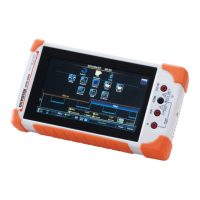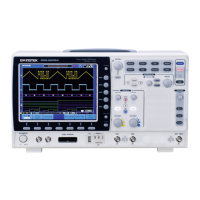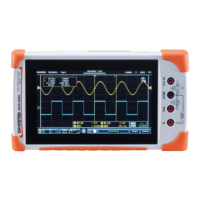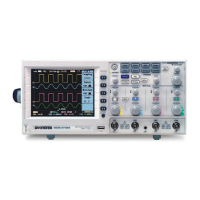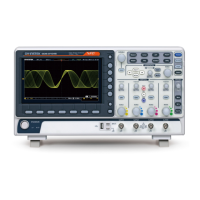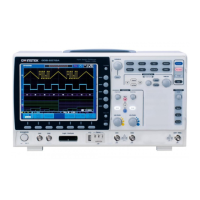Do you have a question about the GW Instek GDS-2202A and is the answer not in the manual?
Explains various safety symbols used in the manual and on the device.
Provides essential guidelines for safe operation and handling of the instrument.
Guides the user through initial setup steps like tilt stand, module, and software installation.
Explains menu tree conventions and shortcuts for operating the oscilloscope.
Covers fundamental operations like channel activation and deactivation for signal viewing.
Explains how to use automatic measurement functions for voltage, current, time, and delay measurements.
Details the use of horizontal and vertical cursors to measure waveform positions and values.
Explains the acquisition process and how to select different acquisition modes.
Introduces various trigger types like Edge, Delay, Pulse Width, Video, etc.
Explains common parameters applicable to all trigger types, such as Source, Mode, and Coupling.
Covers configuration of USB, RS-232C, Ethernet, Socket Server, and GPIB interfaces.
Details the steps for compensating the oscilloscope probe for accurate measurements.
Lists the model-specific technical specifications for the GDS-2000A series oscilloscopes.
Explains various safety symbols used in the manual and on the device.
Provides essential guidelines for safe operation and handling of the instrument.
Guides the user through initial setup steps like tilt stand, module, and software installation.
Explains menu tree conventions and shortcuts for operating the oscilloscope.
Covers fundamental operations like channel activation and deactivation for signal viewing.
Explains how to use automatic measurement functions for voltage, current, time, and delay measurements.
Details the use of horizontal and vertical cursors to measure waveform positions and values.
Explains the acquisition process and how to select different acquisition modes.
Introduces various trigger types like Edge, Delay, Pulse Width, Video, etc.
Explains common parameters applicable to all trigger types, such as Source, Mode, and Coupling.
Covers configuration of USB, RS-232C, Ethernet, Socket Server, and GPIB interfaces.
Details the steps for compensating the oscilloscope probe for accurate measurements.
Lists the model-specific technical specifications for the GDS-2000A series oscilloscopes.
| Bandwidth | 200 MHz |
|---|---|
| Sample Rate | 2 GSa/s |
| Channels | 2 |
| Vertical Resolution | 8 bits |
| Input Coupling | AC, DC, GND |
| Power Supply | 100-240 VAC, 50/60 Hz |
| Display | 7-inch TFT LCD |
| Input Impedance | 1 MΩ || 16 pF |
| Trigger Modes | Edge, Pulse, Video |
| Interface | USB, LAN |
| Trigger Types | Edge, Pulse Width, Video, Slope, Alternative, Delay, Time out, Event-Delay (N), Logic |
| Display Resolution | 800 x 480 pixels |
| Interface (Optional) | GPIB |
| Weight | 2.8 kg |

